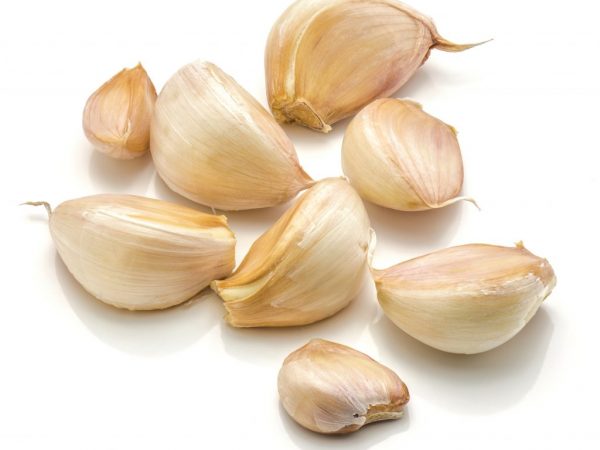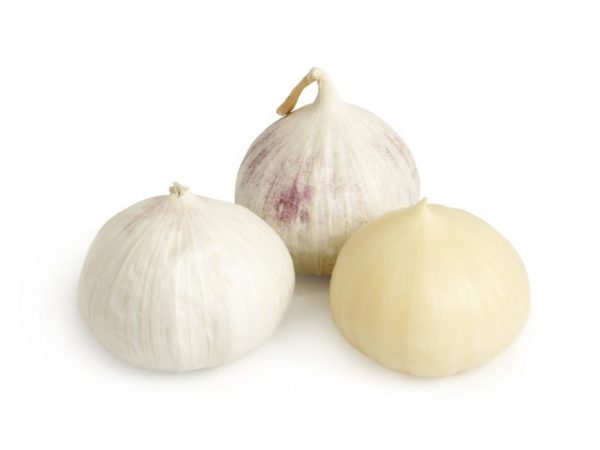Description of garlic varieties Lyubasha
Some gardeners choose to grow winter garlic varieties. They are early ripening, do not require special care. They have a high level of productivity. The Lyubasha garlic variety is in great demand in the market.

Garlic variety Lyubasha
Designed for cultivation in Russia, Ukraine, Belarus, Moldova. It tolerates drought or rainy weather very well. Lyubasha's garlic is undemanding to soil and climatic conditions.
Characteristics of the variety
The Lyubasha variety is grown in winter. This is due to the frost resistance of the bulbous plant. Its height is on average 100-120 cm. If the soil is of good quality, it can grow up to 1.5 m.
Description of garlic
- the average number of teeth in one head - 7 pcs .;
- weight - 60-130 g;
- light pink tint of the outer shell of the clove;
- the color of the outer scales is white.
The description indicates that the leaves are dense, dark green in color. The length is 50 cm, the width is up to 3 cm. Feature - covered with a wax coating, but in small quantities.
Garlic Lyubasha pleases with high yields. The average yield of the variety from 1 hectare is up to 20 tons. This is due to the large size of the head. The fruits are stored for a long time - up to 1 year. They do not lose their presentation, the taste remains the same.
The main feature according to the characteristics is the presence of useful trace elements and a vitamin. Lyubasha contains vitamins B5 and C. It is rich in essential oils, amino acids, selenium and allicin. Thanks to this, they strengthen the human immune system and protect against infectious and viral diseases.
The taste of the vegetable is pleasant, not very bitter and spicy. The aroma is long lasting and strong. Lyubasha is used for Asian and Ukrainian cuisine. It is perfect for winter storage. On its basis, soups, broths are made, added to pilaf.
Planting varieties

Lyubasha loves warmth
The technology of growing Lyubasha's garlic is standard. First, decide on a landing site. According to the description, the variety is thermophilic, demanding good lighting. Otherwise, the heads will be small, the taste is subtle, and there will be no pleasant aroma. Therefore, the area should not be in the shade.
Training
The planting time for this variety is late October - late November. 3-4 weeks before the start of frost is the best option.
Before planting, loosen and dig up the soil 30-40 cm deep. Be sure to remove weeds, stones, and other debris.
As a planting material, one-tooth or teeth are taken. You need up to 1.5 tons for 1 hectare of land. It needs to be disinfected. You can make a manganese solution. This will increase the plant's resistance to pests.
Fertilize the soil in advance. Use as fertilizer:
- horse dung;
- mullein;
- potassium;
- phosphorus;
- humus.
Top dressing is taken in a ratio of 10 liters per 3-4 m². The manure must be seasoned. Fresh can damage the ground.
Before the planting process, loosen and level the soil again. Make small furrows. Dimensions and depth depend on the description of the planting material. Place sand or ash on the bottom of the hole. This will improve the quality of the soil and positively affect the amount of the crop.
Reproduction
It is possible to grow garlic of the Lyubasha variety on the basis of different planting materials. The onion plant is propagated in the following ways:
- Air bubbles. Pre-sort them by size. In large fields, they are planted with a seeder. If the sowing area is less than 10 hectares, you can plant by hand.
- Single teeth. Subsequently, germination of air-seeds appears. Necessary for growing a full head.
- Teeth. Their sizes are larger than those of the one-toothed. They must be disinfected in advance.
Each type of planting material must be processed, especially the seeds. This is necessary for the sake of safety and to improve the quality of the fruit.
Planting
Air seeds are planted at a distance of at least 15 cm. Keep a distance of 40-45 cm between individual rows. Thanks to this, the garlic bushes of the Lyubasha variety will not interfere with each other's growth.
One-teeth are planted with the heel down. The planting depth is 5-7 cm. Thus, the vegetable will not freeze. The air temperature during planting cannot be lower than 10 ° C. The limitation is 15 ° C.
After planting, mulch the beds. To do this, use:
- fir branches;
- sawdust;
- peat;
- hay;
- fallen leaves;
- needles, etc.
Layer of mulch - 3-6 cm. In addition, cover Lyubasha's garlic with large leaves of corn, sunflower. It does not need re-irrigation or fertilization in the fall. If the beds are covered with snow in late autumn or early winter, the harvest will be excellent.
The description indicates that it is not recommended to plant Lyubasha in one place for more than 2 years in a row. The earth will weaken. The amount of the crop will be reduced by at least 2 times due to a decrease in the weight and size of the heads.
Care

Doesn't need abundant watering
Seeds of Lyubasha's garlic winter well. If mulching was carried out on time, then future fruits will be safe. With the arrival of spring and after the snow melts, the mulch layer must be removed. The plant responds well to sunlight. The soil warms up better. Loosen the soil when the sprouts get stronger.
If the summer period is rainy, there is no need for watering. In drought conditions, water the soil at least once a week.
Shooting period - June. The arrows are pinched off when they reach 10 cm in length. This will increase the growth of the head.
Fertilizer
If the soil is of high quality, then fertilization is not necessary. Otherwise, you can use several typical types of fertilizers:
- Nitrogen. View - liquid mixture. Promotes rapid germination and head formation. Introduced in the spring.
- Mineral. Introduced throughout the entire growing period. Saturate the soil with useful and nutritious substances.
- Urea. A solution is made based on 1 tablespoon of urea and chicken droppings. The ratio of the product to water is 1:10. Submitted once every 2 weeks.
- Potassium chloride. Fertilizes the soil before wintering. You need 15 grams per 1 m².
- Superphosphate. When digging, it is mixed with humus for maximum effect. The dosage is 20 g per 1 m².
- Manure. Introduced, if necessary, the entire growing period. Enough 3-5 kg per 1 m².
Fertilize the soil before planting. The rest of the time is done at the discretion of the gardener.
Harvesting
Lyubasha ripens in mid-July. This is evidenced by yellowed endings on the leaves. Watering stops at the beginning of July, that is, 2 weeks before harvest. This will help avoid the problem of waterlogging in the soil.
The heads are carefully dug out with a shovel. They are obliged to shake off the remnants of the earth.
After collection, Lyubasha's garlic is placed in a dark place. There they are left to dry. When the heads are dry, you need to cut off the stem. Only a small neck is left.
Later, the crop is harvested to a permanent storage place for a period of up to 1 year. A prerequisite is good natural ventilation. For this, small holes are made in the boxes. room temperature not lower than 0 ° C.
Conclusion
Garlic Lyubasha is a Ukrainian winter onion plant variety. Easy to care for - watered once a week, requires feeding only when planting.Immune to pests and fungal infections after treatment with manganese solution.
The main advantage is high yield (up to 20 tons per hectare). Its excellent taste makes it possible to add garlic to a variety of dishes. The strong smell makes them aromatic. Follow all recommendations and get delicious fruits in large quantities! Remember to change your landing site every 2 years!


